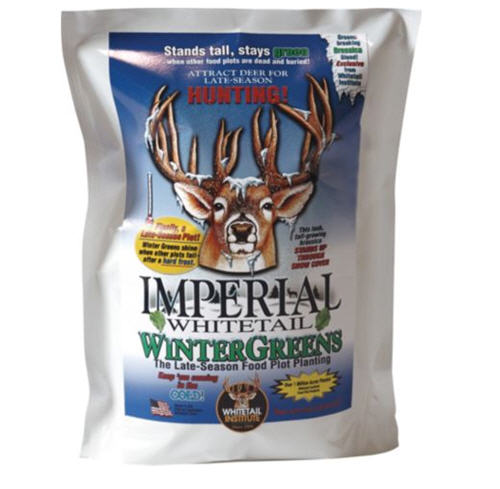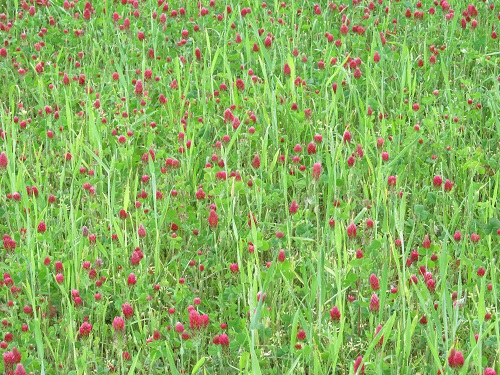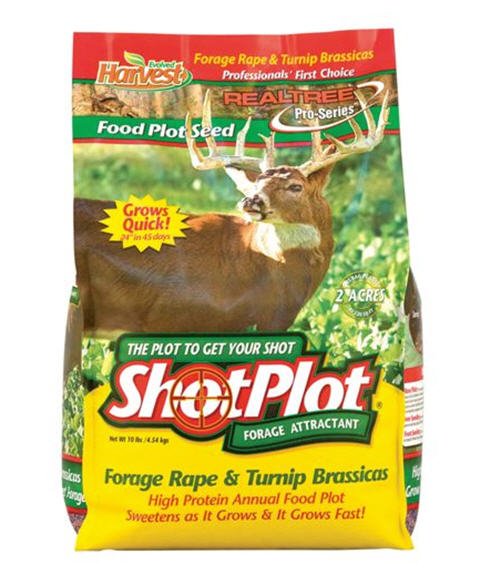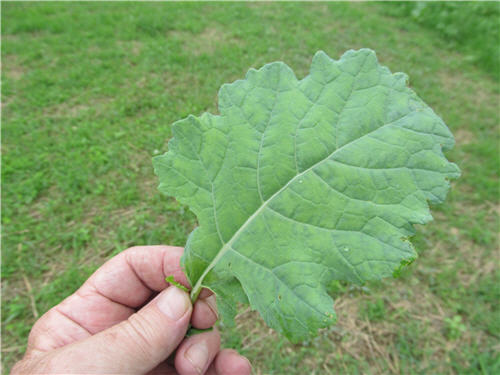
Planting fall food plots doesn’t just entice bucks by offering them succulent forage. It also draws in does, offering the double attraction of food and females. But what plants will offer the most appeal to whitetails from October bow hunts all the way through January’s late rifle and muzzleloader seasons? Find out here.
Shop Feed, Attractants and Minerals for your Food Plot here
Best Perennials and Annuals to Plant

WinterGreens seed
Perennials such as white clover, chicory, and alfalfa are great for nourishing deer and should be included in any whitetail habitat management program. But for sheer attraction for fall hunts, it’s hard to beat two types of annuals: brassicas and cereal grains—planted separately, mixed, or combined with annual clovers. Brassicas can include ***-brassica, kale, turnips, true brassicas, and radishes. The main cereal grains for the deer manager are wheat, oats, and rye.
Both types of plants provide tremendous tonnage of food, strong nutritional value and a taste that deer relish. They can be eaten down heavily and come back strongly. And both can survive deep snow and brutal cold, often providing forage right through winter. Adding to their appeal, they’re easy for even the novice food plotter to grow.
Tip: You can buy single species bags of brassica like the Whitetail Institute Imperial WinterGreens seed and cereal grain seeds or mixtures sold by wildlife seed companies through Cabela’s and Bass Pro Shops. If you just have a couple of small spots for plots, mixtures are best. That way various plants in the blend will reach peak palatability at different times, drawing in deer throughout the fall and winter. And if one plant type doesn’t thrive in your soil conditions, chances are others will.
Shop Food Plot Seeds & Accessories here
Combine Mixtures & Single Species Plots for the Ultimate Appeal

If you have a number of spots for plots or several large areas, the best approach is to plant some mixtures and some pure stands of a single plant such as oats, wheat, turnips, or radishes. The more varied the buffet choice you offer your local deer herd, the more likely most bucks in the area will choose your plots to feed in.
Tip: Just like people, some bucks prefer one forage while another deer might favor a different one. That’s why it’s best to keep your offerings varied.
Best Time of Year to Plant Brassicas and Cereal Grains

Forage Attractant
Brassicas can be planted any time from August through October,depending on your location. Cereal grains work well sown from August through November.
Brassicas Plants

These mustard-type plants with large, bluish-green leaves provide up to 35 percent protein. Brassicas are especially favored by deer in fall after the first few frosts transform starches in the plant to sugars and raise their taste appeal.
Tip: Once deer eat the leaves and any regrowth, some of these plants such as radishes and turnips have large bulbs the deer can consume, digging them up with their hooves. Those can be particularly important in winter when other foods are scarce.
Plant Yields
An acre of *** can produce up to five tons of forage. An acre of radishes can yield up to 6,000 pounds of dry leaf forage plus another ton of roots. Turnips and kale can offer 20-35 percent protein levels. It’s no wonder these plants are so favored by deer managers.
Brassicas Benefits to Soil

Brassicas are not only great for attracting deer and providing them nourishment. They can also help your plots become more
productive for future plantings by combating two common food plot problems—weed competition and compacted soil.
The large leaves in a thriving brassica plot will shade out and kill troublesome weeds and grasses. Some of these plants, turnips and particularly radishes, can also aerate compacted soils that are a common problem in food plots from years of shallow tilling with no deep plowing. Radishes grow a root up to 60 inches deep that breaks up and aerates the soil when it decays, allowing more moisture to penetrate. That enables future plantings to grow deeper and utilize more of the soil’s nutrients.
Preparations for Planting Brassica
To prepare a plot for putting in brassicas, first kill the vegetation present with an herbicide such as Roundup or generic glyphosate. Do a soil test to find out lime and fertilizer needs. Apply those, or add about a ton of lime per acre and a 19-19-19 or similar fertilizer if you haven’t tested. Then till the soil repeatedly until there are no large clumps.

Broadcast the seeds at the rate the seed bag suggests, typically about 4-8 pounds per acre. Then barely cover the seeds, about 1/8-1/4 inch.
Tip: If you’ve created a smooth, firm seedbed, you can actually plant these by broadcasting ahead of a rain and not till them in at all. The precipitation will drive the seeds into the soil.
Tip: To add to the appeal of brassicas you can mix several kinds together or combine them with annual clovers such as arrowleaf or crimson.
Cereal Grains
With few types of natural green forage available from late fall through spring, these crops will attract large numbers of deer and
provide valuable nutrition to help the animals through this difficult period. They will also bounce back strongly and continue producing more green forage as they are eaten down by deer. Prepare the soil just as you did for brassicas then consider these three major cereal grains.

Growing Rye for Deer
Rye, is very popular because it is very easy to grow. Simply spread it out on a tilled plot and you’ll have a field of rye that will attract deer. Disking it in lightly about 1/8-1/4 inch is better and light cultipacking will help it germinate best. Its protein level is modest, at 10-15 percent, but it is a good choice for the beginning food plotter because it’s so easy to grow.
Tip: You can mitigate the low-protein drawback of rye by mixing it with clover, which also adds nitrogen to the soil and improves its taste appeal to deer.
Oats Are Attractive to Whitetails
Oats, are the second major cereal grain to consider. They have higher protein content, in the 15-25 percent range, and deer seem to prefer the taste slightly over rye.
Oats are most attractive to whitetails from when they just emerge up to a height of about 5 inches. After that they’re generally too tough to interest deer. Mixing oats with clover helps improve their taste appeal and protein level, while also distributing browsing pressure.
Tip: If you don’t have enough deer to keep oats down in the 3-5 inch height range, cut the field back with a mower to this height when it gets too tall. New tender growth will emerge and deer will feed heavily on it.
Wheat Has a Taste Deer Love
This is a superb cereal grain for fall plantings, with 15-25 percent protein and a taste deer love. It also comes back strong after being fed on by deer. Both oats and wheat can be planted slightly deeper than rye—1/2-1 inch. Broadcast or drill the seed to that depth and pack the ground lightly for good seed-to-soil contact and germination.
Wheat can survive even the coldest temperatures throughout the U.S. and Canada. As with oats, if you don’t have enough deer to keep it in the optimum 3-5 inch height, mow it down periodically and it will regrow fresh tasty shoots.
.jpg)
Tip: Combining any one of these cereal grains with brassicas is an excellent way to provide maximum fall attraction in a food plot, or you can buy pre-packaged mixes from Bass Pro and Cabela’s. You can see which ones work best that way, and the variety will offer the optimum way to draw in and hold deer on your property.
Creating Prime Hunting Spots
No one would ever want whitetail hunting to be reduced to simply watching a food plot. But by putting in the right seeds as fall approaches, you can make a few strategically-located green fields part of the movement patterns of deer in your area and prime hunting spots you can turn to when conditions are right.
- 15214 views

